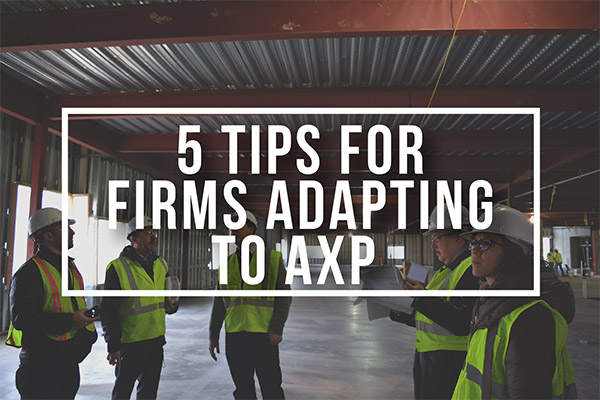Adapting To AXP
July brought more than fireworks and BBQ’s this summer for those on the path towards becoming an architect. A complete overhaul of the experience requirements to become an architect was put into motion, which has the potential to be a game changer for how those in the program gain and record experience.
Formerly known as the Intern Development Program the new Architectural Experience Program (AXP) will require architecture firms to adapt in order to keep young talent advancing towards becoming licensed architects. In 2012 , NCARB conducted a national survey to review the old program and realized changes were needed in order to strive for better independent performance of required tasks at the completion of the program. The new AXP allows licensure candidates the opportunity to be more flexible with the number of hours needed for a particular task. This allows for greater time spent on a challenging task and less on ones candidates find easier, which is a major change from the static hours required in the old highly prescriptive system.
Below are some of the biggest changes within AXP:
- 17 specific IDP experience areas are now 6 broad AXP experience areas
- These 6 areas align with the ARE exams and project phases, essentially
WHAT YOU DO FOR AXP = WHAT YOU STUDY FOR ARE’S = WHAT YOU DO IN THE REAL WORLD!
- There are 96 listed tasks that licensure candidates are expected to have competency in at the completion of AXP.
- Reduction of supplemental experience in favor of firm-related project experience.
5 TIPS FOR FIRMS ADAPTING TO AXP
To efficiently and effectively support those on the path to licensure
- Broaden Impact of Tasks
Firms should encourage those in AXP to broaden the impact of their particular task into a greater network of interconnected tasks. By understanding how different aspects of the building process relate and are interconnected with one another, it is a win-win for both candidate and firm. Firms receive long-term better-informed employees and candidates receive a well-rounded education enabling them to achieve more AXP tasks independently.
- Competency Review Meetings
Supervisors should have candid conversations about how the licensure candidate is making progress toward competency, instead of how their hours are adding up. By focusing on what candidates still need to learn versus simply how many hours they have remaining a firm is in a better position to assign meaningful roles to a candidate and perhaps even set them up with a mentor within the firm who may have the expertise the candidate is looking to acquire.
- Greater Project Exposure
The old notion of an ‘intern’ is one who picks up redlines day-in and day-out, however AXP recognizes this is not fruitful to create well rounded architects. Much of the AXP tasks require licensure candidates to attend various meetings and become active team members throughout the entire project process. From meeting with clients, consultants, the community and city, exposing candidates early on to these processes can make them highly useful for the firm in the future when they can perform these tasks independently.
- Appoint a Firm Licensing Advisor
In order to receive information about all of the NCARB changes and to facilitate the flow of information to architecture students, licensure candidates, and architects about licensure and reciprocity, firms can appoint NCARB architect-licensing advisors. Advisors receive special resources and annual training at the Licensing Advisors Summit to keep advisors up-to-date. Kodet currently has two licensing advisors, and encourages them to be active on the local AIA Minnesota Architect Licensing Advisory Committee as well as nationally.
- Offer Support to Candidates
Perhaps the best way to support candidates on the path to licensure is to give them financial incentives and the flexibility to study and test when it’s convenient for them, becoming a recognized Firm Award winner by AIA is a great way to achieve this and to let future hires know you’re committed to helping people become licensed. From covering AXP & ARE fees, to establishing good mentoring and supervisor roles, firms can set themselves apart and provide meaningful resources to help those achieve licensure without barriers.
Kodet received the 2014-2017 IDP Firm Award and is looking to win again in 2018!
P.S. You may have noticed AXP no longer requires Leadership & Service tasks, however firms should take it upon themselves to encourage leadership in the community, such as AIA volunteering, and service to the community. While no longer required, it’s a great way to give back to communities, make connections, and build relationships with organizations that may just come back as future project opportunities!
Edited by Mandi Tauferner, AIA, SARA, LEED AP – Licensing Advisor

